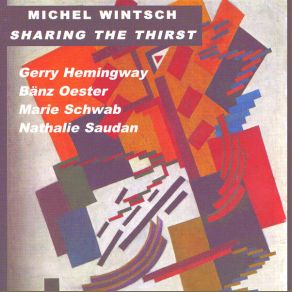Sharing the Thirst
Download links and information about Sharing the Thirst by Gerry Hemingway, Michel Wintsch. This album was released in 2001 and it belongs to Jazz, Avant Garde Jazz genres. It contains 12 tracks with total duration of 01:00:41 minutes.

|
|
|---|---|
| Artist: | Gerry Hemingway, Michel Wintsch |
| Release date: | 2001 |
| Genre: | Jazz, Avant Garde Jazz |
| Tracks: | 12 |
| Duration: | 01:00:41 |
| Buy it NOW at: | |
| Buy on iTunes $9.99 | |
| Buy on Amazon $8.99 | |
| Buy on Songswave €1.73 | |
Tracks
[Edit]| No. | Title | Length |
|---|---|---|
| 1. | Gentian's Edginess | 4:23 |
| 2. | Painter Mikailov | 5:01 |
| 3. | Edelweiss Edema | 5:46 |
| 4. | Alone, But In the Field | 4:44 |
| 5. | Sharing the Thirst | 11:08 |
| 6. | Belly of Nothingness | 3:29 |
| 7. | Two Streets | 2:43 |
| 8. | Drowning Tree | 4:23 |
| 9. | Yesterday's Bowel | 1:41 |
| 10. | Overlapped Hazes | 3:55 |
| 11. | Quixotic | 4:04 |
| 12. | I Love to Feel the Oddity of the World | 9:24 |
Details
[Edit]Pianist/composer Michel Wintsch's music is jazz-based but heavily influenced by elements of contemporary European-derived art music. The band's unusual instrumentation reflects this most directly; the front line is comprised of a violinist and a violist. The presence of one or the other is unusual enough, but for a jazz ensemble to use both is well-nigh unprecedented. By the record's second cut, it's clear that the peculiar lineup is a natural outgrowth of Wintsch's conception. The track, "Painter Mikailov," is built on a gentle bass ostinato, over which the two string players etch a deceptively simple and mildly convoluted melody in unison and two-part harmony. The quiet melody and counterpoint is so completely in keeping with the character of the string instruments that it's all but impossible to imagine it being played by a pair of saxophonists, for instance. Violinist Nathalie Saudan and violist Marie Schwab are skilled, sensitive interpreters of Wintsch's brittle, occasionally Satie-esque melodies, and are perceptive improvisers, besides. They have well-developed classical chops that accommodate the exigencies of improvisation. Drummer Gerry Hemingway has a well-deserved reputation as a colorist. Here his powers of textural transformation and misdirection are put to good use, as he exploits every possible combination of sounds from his kit and opens a variety of avenues down which the improvisations flow. Bassist Banz Oester has a beautiful touch and an unerring sense of place within the ensemble. Wintsch is apparently the band's guiding force; he's given credit for all of the 12 compositions, and it's credit well-taken, for several of the tunes are something more than the skeletal, free-boppish blowing vehicles that are the stock-in-trade of most free jazz bands. While there's no lack of jazz feeling in his playing and writing, Wintsch displays an obvious familiarity with 20th century classical techniques. A composition like the title track, for instance — with its canonic string writing and use of static harmonies — reminds one of Bartok's writing for violin duo. At the same time, Wintsch's quiet strumming on the piano's insides and Oester's striking of his instrument with the wood of the bow reflect other, later classical performance practices. Hemingway maintains a strong-swinging jazz presence, providing the essential rhythmic qualities that place the music firmly in the jazz realm. This is music of a very high quality — expertly played, deeply felt, and original in content.